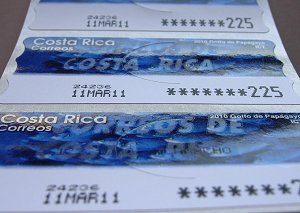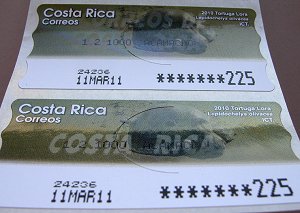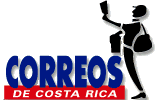| The
ATMs in Costa Rica (II). The EPELSA models |
|
 |
| The EPELSA franking balances |
From the Plan de desarrollo informático 2000-2002 (Computer development plan), Correos de Costa Rica began an ambitious technological plan, in 2001, that tried to set in motion an integrated computer network for the management of all the services of the company.
Between the projects included in this Plan, promoted by the computer management of Correos de Costa Rica, there was the so-called 'Desarrollo del sistema de puntos de venta' (Development of the point of sale system), with the installation of a total of 150 franking scales and the development of a new computer system integrating all the equipment, and covering all the services offered by Correos de Costa Rica.
From 2002 the installation of the EPELSA franking scales began: 83 machines were installed by March 2003, rising to 120 by September 2003, up to the maximum of 148, in all the Correos de Costa Rica postal branches around the country.
The machine or serial number of these scales, that is printed on the ATMs, is between 24106 and 24255.
These franking balances are the standard RL-POSTAL model, incorporating the special markings (like colours and logos) owned by the Correos de Costa Rica, S.A. |
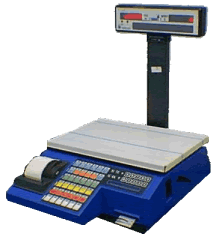 |
As in Spain, this balance can be used in two ways, but only by postal employees - either to print ATMs or, if attached to the computer system, to allow the postal clerk to issue an ATM according the weight, type and destination of the shipment.
The franking balances also print a receipt on thermal paper, which has a pre-printed logo, and complete information of the purchase. |
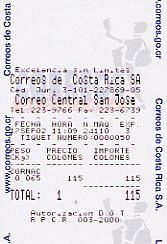 |
| Receipt for the purchase of one ATM with a value of 115 ¢. Size : 60 x 90 mm. |
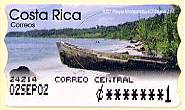 |
Subject
:
|
|
2002
- Playa Manzanillo (Manzanillo's beach) - ICT-Bruno J.M. |
| Date
of issue : |
|
July
16, 2002 |
|
Size
:
|
|
47
x 27 mm. |
|
Paper
:
|
|
Thermal
self adhesive - multicoloured |
|
Printing
value :
|
|
Thermal
on black |
| Possible
values : |
|
1
to 99999 ¢ (in steps of 1 ¢) |
|
Design
:
|
|
Correos
de Costa Rica, S.A. - ICT-Bruno J.M. |
| Printer
: |
|
Ovelar,
Spain |
| Click
on the image to enlarge |
Printing
:
|
|
1st.
print.: 2.280.000 adhesives (1.200 rolls)
2nd. print. (2003): 1.900.000
adhesives (1.000 rolls) |
Playa
Manzanillo (Manzanillo beach), is a wonderful natural scenic location on the South-east Caribbean coast, used as a subject for the 1st ATM issued from the new EPELSA - model RL-POSTAL franking balances, used in Costa Rica’s post offices.
On July 16th 2002, 9 years after the previous ATM issue in Costa Rica, the first 10 franking balances were installed in the main post office in San Jose. The equipment is only used by the postal clerks and is located at the customer service desk. This dispenser is programmed to issue thermal ATMs and prints the machine number, the name of the city or post office, the date and, of course the face value. Despite the inclusion of the date, users are able to use the ATMs (or sello balanza -balance stamp- as they call them) as normal stamps at any place or date, according to the official information issued by the Gerencia General de Correos de Costa Rica, S.A.
| The image shows a mixed franking with both "traditional" stamps and one ATM issued on September 17th 2002. The letter was posted on October 4th. |
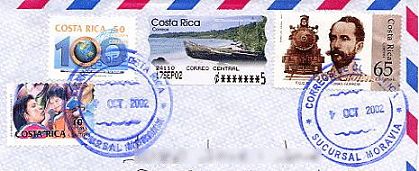 |
Ovelar manufactured 1,200 rolls of this first design, with 1,900 adhesives on each roll.
In 2003 they did a reprinting of the same design with 1,000 new rolls. The new labels have a variation in shade. |
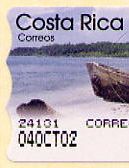 |
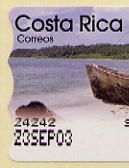 |
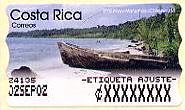 |
The new ATM issue benefits from the vast experience gained from the ATM thermal issues in Spain, with the same format in paper and similar characteristics in the printing by the franking balances.
Adjust
label - Balance 24135
|
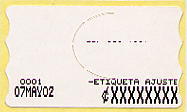 |
In the commercial Exhibition held in Madrid on the occasion of the Postal Forum (May 6 to 8th 2002), one could see the prototype of the Epelsa franking balance installed in Costa Rica, and at the same time the first adjust label was issued. In this case it was printed on a blank label because the 1st paper hadn't yet been produced. |
The printing errors of the franking balances and the varieties are very similar to those found on Spanish ATM issues.
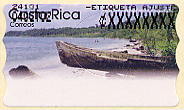 |
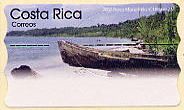 |
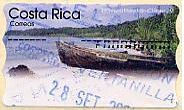 |
| Adjust
label with misplaced printing |
Printing
of horizontal lines |
Printing
error cancelled ... maybe
to avoid its use as a franking? |
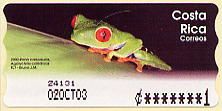 |
Subject
:
|
|
2002-
Rana calzonuda (Gaudy Leaf Frog), Agalychnis callidryas.
ICT-Bruno J.M. |
| Date
of issue : |
|
September
24th 2003 |
|
Size
:
|
|
57
x 27 mm. |
|
Paper
:
|
|
Thermal
self adhesive - multicoloured |
|
Printing
value :
|
|
Thermal
on black |
| Possible
values : |
|
1
to 99999 ¢ (in steps of 1 ¢) |
|
Design
:
|
|
Correos
de Costa Rica - ICT-Bruno J.M. |
| Printer
: |
|
Ovelar,
Spain |
| Click
on the image to enlarge |
Printing
:
|
|
2,850,000 adhesives (1.500 rolls) |
The new ATM issue show a beautiful image of the Redeye or Gaudy Leaf Frog, an amphibian living mainly in the rain forests of Panama, Nicaragua and Costa Rica.
Correos
de Costa Rica wanted to take advantage of the large number of options that the new Epelsa scales offer, so that for special postal handling (Registered, Express - EMS, ...) a control label could be printed, on the same self adhesive paper.
As a result the following issues are larger, sized 57 x 27 mm. to allow the printing of a bar code type 39 - the standard recommended by the UPU.
(Simulation)
|
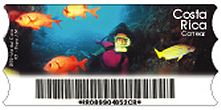 |
The modifications to both the software and the balances were incorporated between September and November 2003. The first balances to use the new papers (model Calzonuda Frog) were the 12 units installed in the Main Post Office of San Jose, from September 24th.
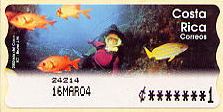 |
Subject
:
|
|
2002-
Isla del Coco (Coco's Island). ICT-Bruno J.M. |
| Date
of issue : |
|
February
16th 2004 (1st. known date) |
|
Size
:
|
|
57
x 27 mm. |
|
Paper
:
|
|
Thermal
self adhesive - multicoloured |
|
Printing
value :
|
|
Thermal
on black |
| Possible
values : |
|
1
to 99999 ¢ (in steps of 1 ¢) |
|
Design
:
|
|
Correos
de Costa Rica - ICT-Bruno J.M. |
| Printer
: |
|
Ovelar,
Spain |
| Click
on the image to enlarge |
Printing
:
|
|
2,850,000
adhesives (1.500 rolls) |
The third thermal type design is dedicated to one of Costa Rica’s highlights, the National Park of Coco's Island. This is the largest uninhabited island on the planet. A huge nature reserve declared as a Natural Patrimony of the Humanity by UNESCO, in 1997. The island is also well known as one of the best places anywhere in the world for scuba diving.
The rolls of this design were manufactured at the same time as the Calzonuda Frog design, although it was finally decided to use them consecutively, in the balances.
The first ATMs of Coco's Island were issued from the balances of the San Jose Main Post Office in the middle of February 2004.
 |
Related to this ATM issue, Correos de Costa Rica, in June 2003, issued one set of two stamps dedicated to the 25th anniversary of Coco's Island National Park. |
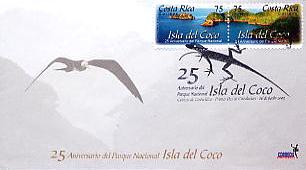 |
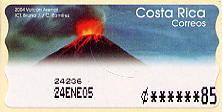 |
Subject
:
|
|
2004
- Volcan Arenal (Arenal Volcano). ICT-Bruno J. / C. Ramirez
|
| Date
of issue : |
|
November
13th 2004 (1st. known date) |
|
Size
:
|
|
57
x 27 mm. |
|
Paper
:
|
|
Thermal
self adhesive - multicoloured |
|
Printing
value :
|
|
Thermal
on black |
| Possible
values : |
|
1
to 99999 ¢ (in steps of 1 ¢) |
|
Design
:
|
|
Correos
de Costa Rica - ICT-Bruno J. / C. Ramirez |
| Printer
: |
|
Ovelar,
Spain |
| Click
on the image to enlarge |
Printing
:
|
|
2,827,200
adhesives (1.488 rolls) |
A new ATM issue dedicated, again, to one of Costa Rica natural highlights, - the National Park Arenal Volcano.
Located in the Costa Rican Northwest region, between the Tilaran mount and the San Carlos Plains, the Arenal Volcano (1633 m. high) currently remains active. For many years it was considered inactive and it was known as Arenal Hill until, in 1968, it suddenly and violently erupted and destroyed the two nearby towns of Pueblo Nuevo and Tabacon. After a period of calm, the volcano returned to being active in 1981.
The first rolls of this design were used in the franking balances of the San Jose Main Post Office from November 13th 2004.
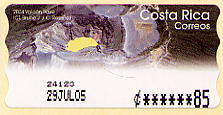 |
Subject
:
|
|
2004
- Volcan Irazu (Irazu Volcano). ICT-Bruno J. / C. Ramirez |
| Date
of issue : |
|
April
8th 2005 (1st. known date) |
|
Size
:
|
|
57
x 27 mm. |
|
Paper
:
|
|
Thermal
self adhesive - multicoloured |
|
Printing
value :
|
|
Thermal
on black |
| Possible
values : |
|
1
to 99999 ¢ (in steps of 1 ¢) |
|
Design
:
|
|
Correos
de Costa Rica - ICT-Bruno J. / C. Ramirez |
| Printer
: |
|
Ovelar,
Spain |
| Click
on the image to enlarge |
Printing
:
|
|
2,872,800
adhesives (1.512 rolls) |
As with previous ATM issues, there are no official first day covers, and the postal use of this new design in the franking balances started when the rolls of the previous design were exhausted.
Some printing tests are known at the beginning of April 2005, although their use in balances did not start until July 2005.
The National Park Irazu Volcano is located in the Central Volcanic Chain, closer to Cartago.
At 3432 meters above sea level, the Irazu Volcano is the highest in Costa Rica. The Irazu is still active, and has a long history of eruptions. The last one was in 1963. At the bottom of the crater is a green sulphur lake with steam vents. The name comes from the Indian word Iaratzu, which mean the mountain of trembling and rumbling. The Irazu volcano is a tourist highlight in Costa Rica ... Another great reason to visit the country !
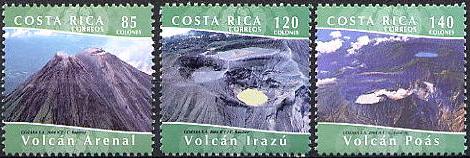 |
In June 2004 Correos de Costa Rica issued a set of 3 stamps commemorating the 25th anniversary of the National Park Foundation. One of the stamps is dedicated to the Arenal Volcano National Park, and another one to the Irazu Volcano National Park. |
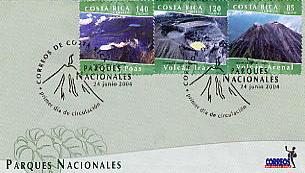 |
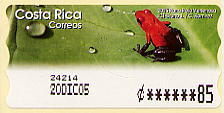 |
Subject
:
|
|
2005
Rana Roja Venenosa (Strawberry Poison Frog). ICT-Bruno
J./C. Ramírez |
| Date
of issue : |
|
November
2005 |
|
Size
:
|
|
57
x 27 mm. |
|
Paper
:
|
|
Thermal
self adhesive - multicoloured |
|
Printing
value :
|
|
Thermal
on black |
| Possible
values : |
|
1
to 99999 ¢ (in steps of 1 ¢) |
|
Design
:
|
|
Correos
de Costa Rica - ICT-Bruno J. / C. Ramirez |
| Printer
: |
|
Ovelar,
Spain |
| Click
on the image to enlarge |
Printing
:
|
|
2,827,200
adhesives (1.488 rolls) |
The Flaming or Strawberry Poison Frog (Dendrobates pumilio) is another typical amphibian living mainly in the rain forests of Panama, Nicaragua and Costa Rica.
These small frogs are characterised by their red colour, (a warning to predators), and their small size, around 20-25 mm. They are known also as blue-jeans, because of the blue or black colour in the lower part of the body.
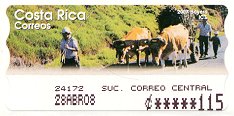 |
Subject : |
|
2007 Boyero (Ox cart driver). ICT |
| Date of issue : |
|
February 2008 |
Size : |
|
57 x 27 mm. |
Paper : |
|
Thermal self adhesive - 4-colors offset |
Printing value : |
|
Thermal on black |
| Possible values : |
|
1 to 99999 ¢ (in steps of 1 ¢) |
Design : |
|
Correos de Costa Rica - ICT |
| Printer : |
|
ETIPRES S.A., Costa Rica |
Printing : |
|
4,000 rolls of labels |
After some changes in the management in charge of technological developments at Correos de Costa Rica, and more than 2 years after the previous issue, a new ATM design was used, from February 2008, in the franking balances installed in the San José main post office (Correo Central).
Again, there was no 'official' first day of issue, so no commemorative postmark was prepared as these ATMs are considered 'postal' and not 'philatelic' issues.
As with previous issues, the label size is 57 x 27 mm. and is printed on self-adhesive thermal paper with a central security score mark. Some of their features differ from previous issues and the manufacturer is no longer the Spanish company Ovelar, S.A.
The new design (from a picture by the Costa Rica Tourism Board - ICT) shows the picture of a boyero, the traditional Costa Rican farmer with his oxcart.
The boyeo (ox herding) and the typical oxcart tradition (depicted in the first Klüssendorf issue) were proclaimed in 2005 by the UNESCO as one of the Masterpieces of the Oral and Intangible Heritage of Humanity.
Costa Ricans are very proud of their tradition and history and every year they celebrate the Día del Boyero (Boyero day) in San Antonio de Escazú, with oxcart parades. |
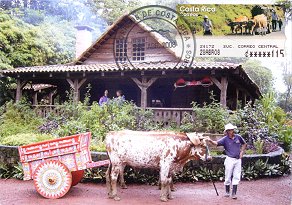 |
| Since its installation in 2002, the Epelsa franking balances have printed all information - the balance number, the issue date, the name of the postal branch (in some cases - SUC. CORREO CENTRAL in the picture), and the 8-digit face value, preceded by the colón symbol (¢), on the label's lower blank area. |
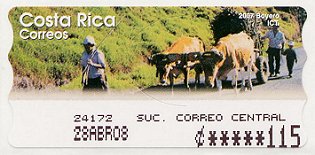 |
Later in 2008, the IT department of Correos de Costa Rica began changing the balances printing, to improve the security of issues.
On some of the scales they set aside 3 lines at the top of the stamp for the possible programming of fixed texts (see right upper picture - TEXTO FIJO ESTAMPILLA 1 - 2 & 3), and they added the service, branch and postal employee codes, which were not always visible, in the centre of the label, depending on the design of the label (1.1.2200 OLACAYO - in the right picture).
The right image below shows a stamp that already includes the fixed programmed texts, in this case Jose Rosales Ponce, probably the name of the employee in charge of the franking scale. The codes 1.1.1200 JSOLANO are also printed in the centre of the stamp. |
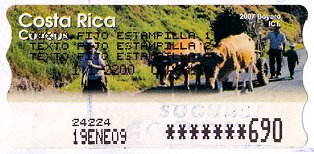 |
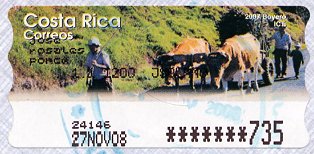 |
In the lower area, they retained the balance number and the date of issue, but removed the name of the postal branch, to allow the face value to be moved slightly upwards. The colón symbol in front of the 10 character face value was deleted.
| The latest version includes the service, postal branch and postal employee codes, at the centre of the label (1.2.1000 ACAMACHO, in the image), whilst in the lower blank area are the balance number, the date of issue and the 10-digit face value, without the colón symbol. |
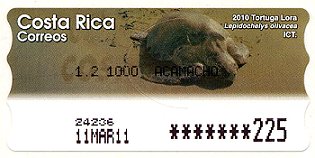 |
| Many of the franking balances in Costa Rica work independently of the central computer system, so that any programming changes must be made individually, and a technician must travel to each post office to do this. For this reason, it has been possible to obtain different design ATMs with these 3 impressions, since 2008, depending on the postal branch, and whether or not any changes to the balance have been made. Indeed, even at the time of writing this article (March 2011), some franking balances still have the original impression. |
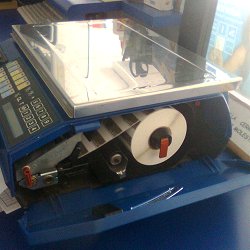 |
| 2010. Golfo de Papagayo and Tortuga Lora |
In mid-2010, when stocks of the previous design - Ox cart driver, produced in 2007, were very low, Correos de Costa Rica ordered the production of new rolls of labels for the Epelsa franking balances in service. Following the proposed designs, rolls were manufactured with 2 new designs, dedicated to the Golfo de Papagayo and the Tortuga Lora.
As is usual in this country, Epelsa ATM issues are not considered as philatelic material, so neither special items nor a first day postmark were produced. The rolls arrived at the warehouses of the company, and distributed to different post offices throughout the country.
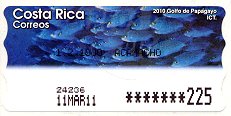 |
The first issue is dedicated to the tourist area - the Gulf of Papagayo, from pictures supplied by the Costa Rican Tourism Board (ICT). It shows the image of a shoal of reef fish.
This design was first used in the Correo Central or San José main post office counters on August 25th 2010. |
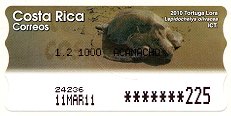 |
The next issue is dedicated to the Olive Ridley sea turtle or Lora turtle (Lepidochelys olivacea). This is the smallest of sea turtles and spawns on the Pacific beaches of Costa Rica. Photography is also by the ICT.
It was first used in the San Jose main post office on September 1st 2010. |
The rolls of both issues were manufactured, again, by the Costa Rican company ETIPRES S.A. The labels are produced using self-adhesive thermal paper, printed by letterpress, with a holographic varnish -or foil impression- on the surface finish design. The size of the labels is 57 x 27 mm., on white waxed backing paper. For security, the labels include the usual central C score and, for the first time, a spot varnish with the text CORREOS DE COSTA RICA, in 2 lines, visible only when tilting the stamp slightly, in front of a light.
Letters
up to 20 g. |
NATIONAL |
INTERNATIONAL
- Priority mail |
| . |
National |
Central
America |
North
and South
America, Antilles |
Europe |
Asia,
Africa
and Oceania |
| 2001 |
65 ¢ |
80 ¢ |
95 ¢ |
115 ¢ |
140 ¢ |
| 2002 |
75 ¢ |
90 ¢ |
110 ¢ |
130 ¢ |
170 ¢ |
| 10.06.2004 |
85 ¢ |
95 ¢ |
120 ¢ |
140 ¢ |
185 ¢ |
| 20.04.2006 |
115 ¢ |
125 ¢ |
155 ¢ |
180 ¢ |
240 ¢ |
| 11.2008 |
140 ¢ |
160 ¢ |
170 ¢ |
190 ¢ |
240 ¢ |
| 01.2010 |
225 ¢ |
330 ¢ |
350 ¢ |
395 ¢ |
495 ¢ |
|
|
|
|
|
|
ATM Web - Spain and Latin American Postal Services: http://www.ateeme.net
© J. Jove - M. Sans. ATEEME. Variable value stamps study group. All rights reserved
This page was created in 2000 and last updated:
16.04.11
. English edition rewritten by S. Goodman (06.04.11)
|































